The A-110-2 Basic VCO is built on the same technical basis as the “standard” VCO A-110-1 that has been available for a long time. Like the A-110-1, it uses circuitry to keep the temperature-sensitive parts of the oscillator at around 50°C. With 8 TE, it is a bit narrower than the 10 TE wide A-110-1, significantly cheaper and also more economical in some details.
On the other hand, no savings were made on two topics that until now could only be found in the twice as expensive A-111-1 or A-111-2: softsync and linear frequency modulation. In principle, the A-110-1 VCO offers soft sync and linear frequency modulation, but – and that was too great a limitation for many – you had to do some soldering work and then attach two additional sockets somewhere. The result then often looked slightly “tinkered”.
The A-110-2 now brings these previously untapped softsync and linear frequency modulation options to the front panel.
What was left out?
The multi-stage octave selector switch from the A-110-1 has given way to a simple toggle switch -1/0/+1 octave. If, for example, you want to “spread” the distances further when using several A-110-2 VCOs, you have to make do with an additional control voltage (e.g. using the A-176 Manual CV Source or with the additional octave switches on the A-185-2 Precision Adder).
Only one input socket is available for pulse width modulation; the A-110-1 has two input sockets (one without an attenuator).
In contrast to the A-110-1, the A-110-2 does not have a sine output. If necessary, you have to use the triangular signal and add a low-pass filter or use the new A-184-2 sine converter. But then the package becomes wider and more expensive than an A-110-1. Ideally, both (A-110-1 and A-110-2) are combined and the two VCOs are used according to their respective strengths.
User interface
Inputs:
System bus: The VCO can get its pitch control voltage from the system bus, for example via an A-185-1 Bus Access or A-185-2 Precision Adder / Bus Access Module attached there. Unfortunately, the very practical switching socket from the A-110-1, with which the control voltage from the bus could be interrupted and replaced by an externally supplied voltage, was omitted. Voltages at the “1V/Oct.” socket are therefore added to the control voltages on the bus.
As with all VCOs with CV control via the bus, you should deactivate this option if you are not using it: Otherwise, the open lines could work as “antennas” and pick up interference signals.
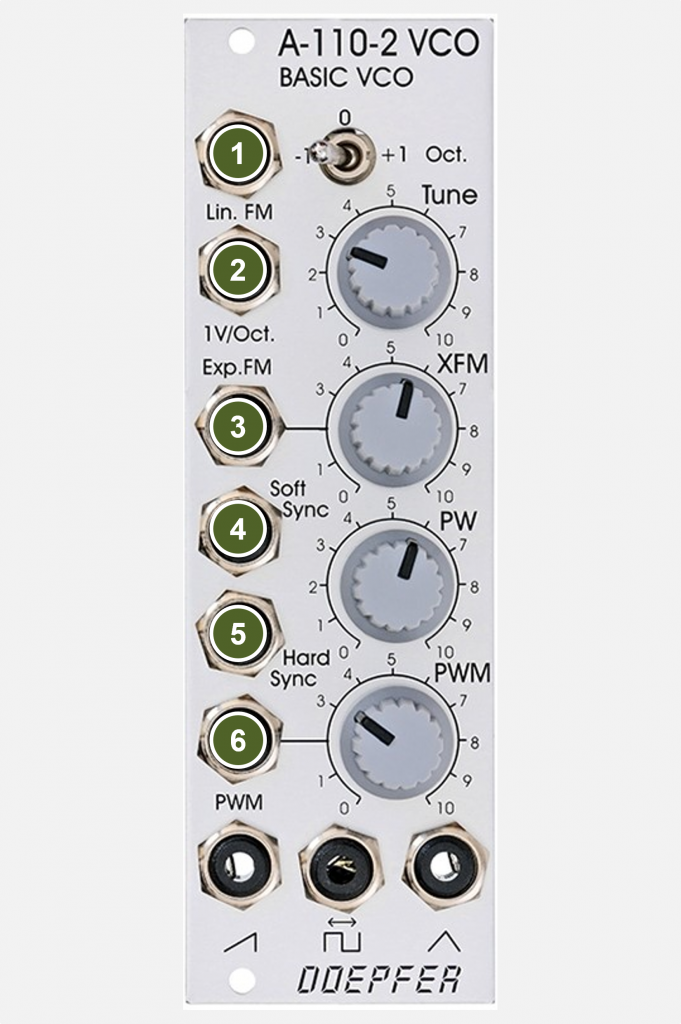
- Lin. FM: Control voltage input for linear frequency modulation. Linear means that for each volt of additional voltage, the frequency of the oscillator increases by the same amount.
- 1V/Oct.: Input for controlling the frequency of the VCO with a keyboard, etc. This input corresponds to the “CV1” input on the A-110-1.
- Exp. FM: Like the “1V/Oct” input, this input works with exponential characteristics. Here you could, for example, connect a sequencer etc. in addition to the keyboard.
- Soft Sync: The input is used to match the frequency of the VCO to that of a “master” VCO.
- Hard Sync: For synchronization with another oscillator. When the voltage at this input falls below a certain level (falling edge), the oscillation cycle of the oscillator is restarted.
- PWM: Input for a control voltage for pulse width modulation of the square/pulse waveform. There is also a “PWM” attenuator for the input voltage here.
Outputs:
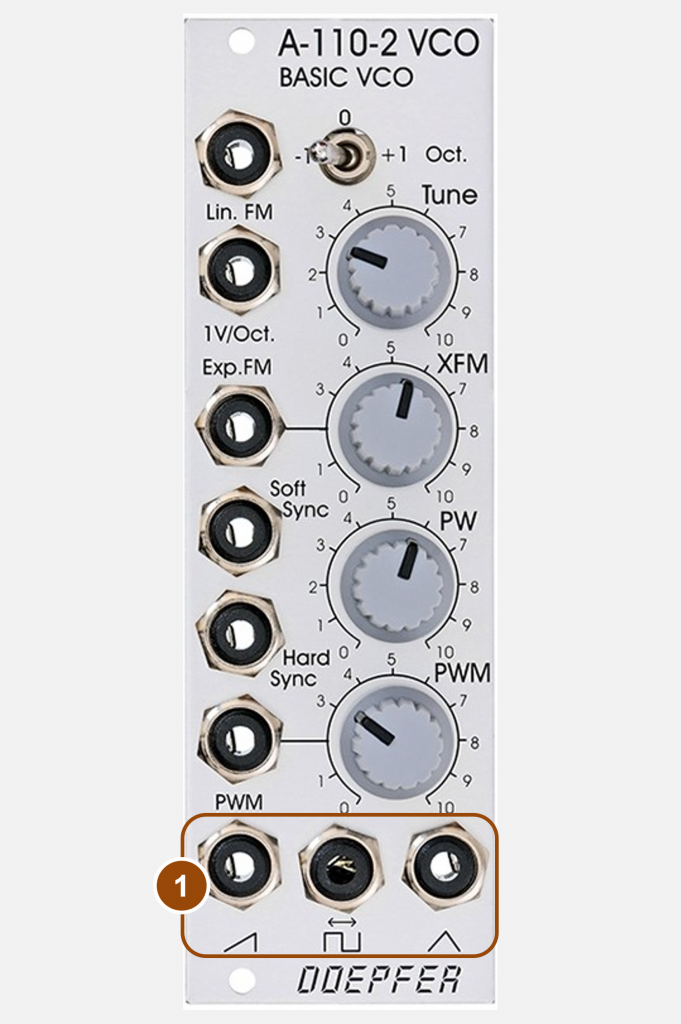
- One separate output each for sawtooth, pulse and triangle. (The sawtooth also has a falling edge like the A-110-1, the symbol is printed backwards here.)
Controls:
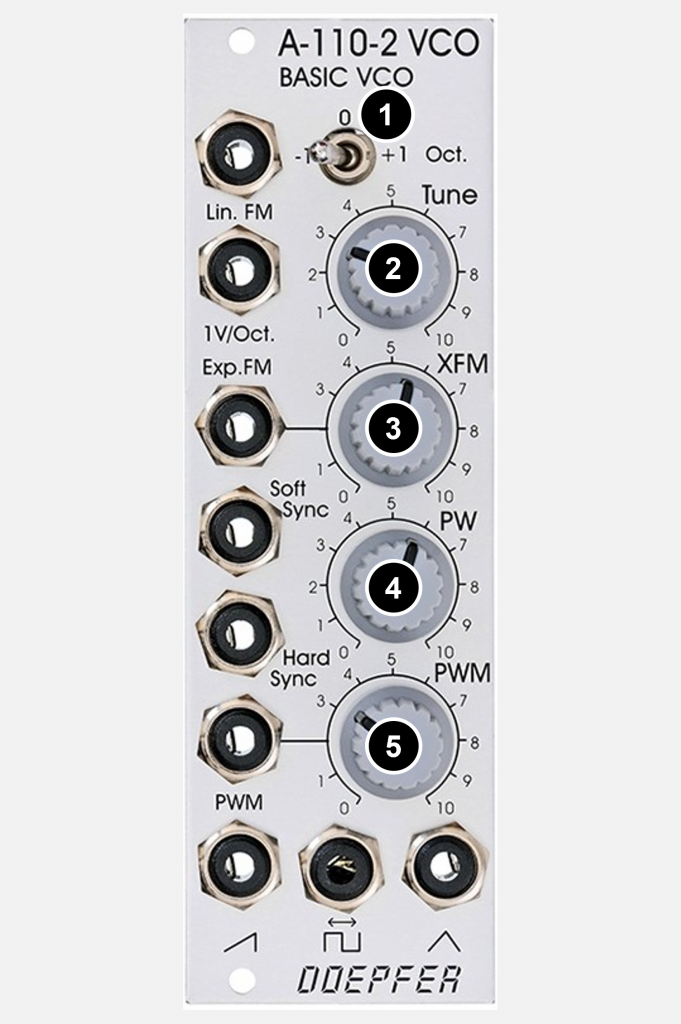
- Oct.: For quickly switching the pitch by +/- an octave.
- Tune: Control for setting the tuning of the oscillator. With the help of a jumper on the circuit board, this control can either set a range of 1/2 octave or 4 octaves. In the latter case, the controller must of course be set much more “sensitively”.
- XFM: Attenuator for the exponential frequency modulation by the control voltage at the “Exp. FM” input.
- PW: Control for manual adjustment of the pulse width (affects only the pulse output).
- PWM: Attenuator for the control voltage at the “PWM” input for pulse width modulation (pulse output only).
Configuration via the board
The module has (like almost all newer Doepfer creations) a whole series of jumpers to adjust the properties of the module to the individual needs of the owner.
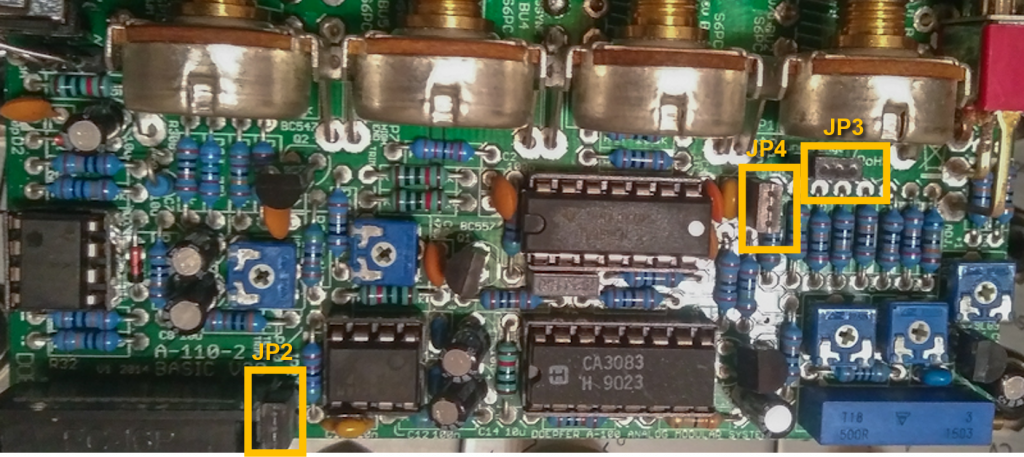
- JP2: CV connection to the A-100 bus
- JP3: range of the Tune control (set = approx. 4 octaves, not set = approx. 1/2 octave)
- JP4: Linear FM input DC/AC coupling (set = DC coupled, unset = AC coupled)
How does that thing vibrate?
Since the A-110-2 is based on the A-110-1, one would expect it to sound no different from the original VCO. And indeed, on the oscilloscope, you see very little difference between the two oscillators. Only the triangle, which otherwise shows a characteristic notch in oscillators with Sawtoth core, is a little different here with a small “tooth” at the negative half-wave. Maybe that’s just a question of fine-tuning, I don’t have another A-110-2 to compare (however, my 7 A-110-1 VCOs all show the “notch” and none the “tooth”).
Sawtooth:

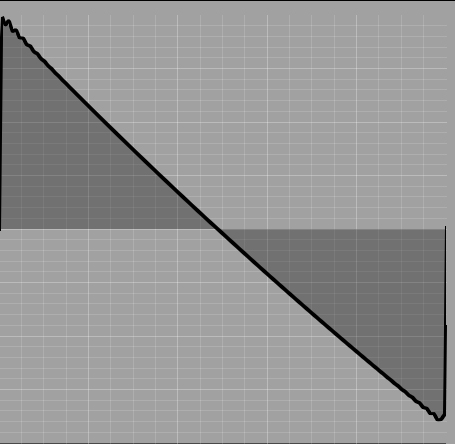
Note: The sawtooth edge is printed on the control panel as a rising edge, but the VCO (like the A-110-1) generates a falling edge.
Triangle:


Square:
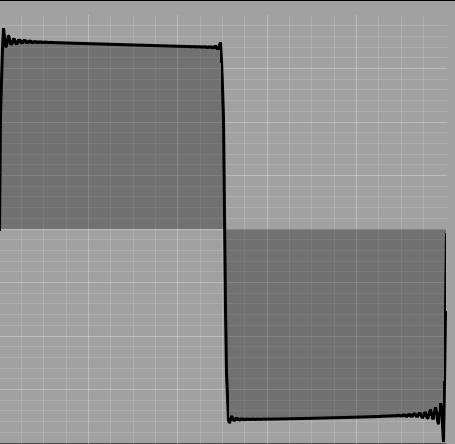
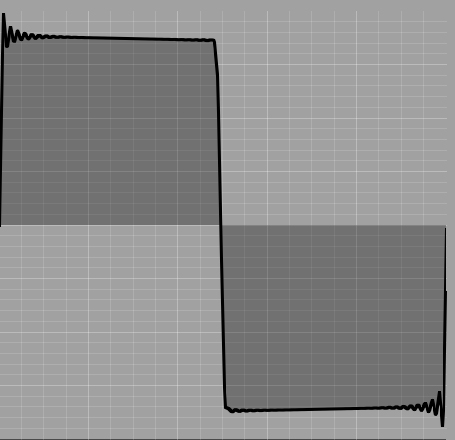
Pulse:

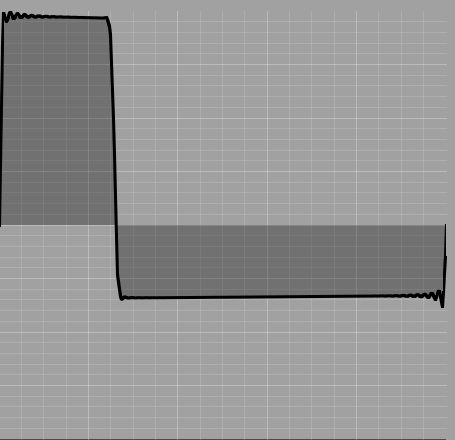
Soft- and Hardsync
Unlike the A-110-1, the A-110-2 has both hardsync and softsync inputs (the A-110-1 has only one hardsync input on the panel).
The oscilloscope images show the synchronized triangle from the A-110-2 (slave), which is synchronized by an A-111-1 VCO as master.
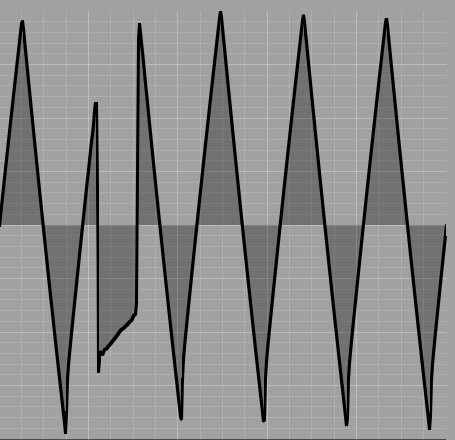

Sound examples
-
A-110-2 / Basic waveforms
The four basic waveforms in the A-110-2: sawtooth, triangle, square and pulse:
Sawtooth from the A-110-2. Triangle from the A-110-2. Square from the A-110-2. Pulse from the A-110-2. -
A-110-2 / Softsync & hardsync
In the two sound samples, an A-111-1 VCO was tuned to C2 as the master, and the “slave” A-110-2 synchronized with it was tuned to C5. When synchronizing, the master determines the basic pitch. We hear the A-110-2 being manually run through from C5 to C4 and back up to C5, the triangle signal is used at the output of the A-110-2.
Hardsync with the A-110-2 (analogous to the sync of the A-110-1). Softsync with the A-110-2.
Technical specifications
| Width | 8 HP |
| Depth | 50 mm |
| Power requirements | 150mA (heating up) / 60mA (+12V) / -30mA (-12V) |
